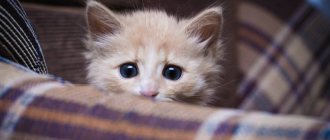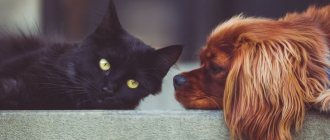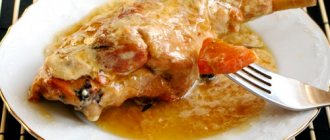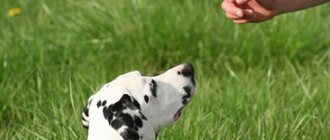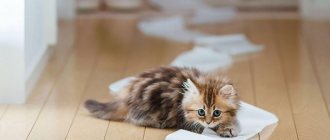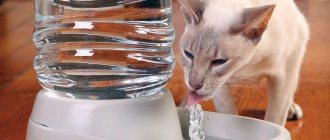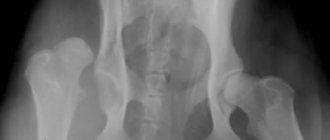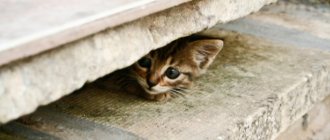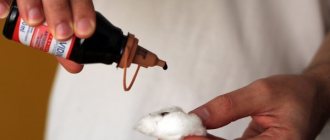9739Administration
Usually, a furry baby that appears in the house develops quickly, which certainly pleases its owners. But quite often it happens that it does not reach the required size at a certain age. An attentive owner will immediately notice this and think about why the kitten is not growing and how to fix it.
In this situation, only a veterinarian can give a complete, and most importantly, correct answer after an individual examination of the animal. After all, the topic of poor growth of pets is relevant and requires certain knowledge to correct the situation.
© shutterstock
Why is the cat thin and not getting fat?
The normal weight of a cat is between 3.5 and 5 kg.
It all depends on the breed. Cats of different origins differ in activity, dynamics and metabolism. In adulthood, the individual reaches 7-8 kg. You can find out why a cat doesn’t get fat if you understand how nutrition affects your pet’s body. When a cat is thin and does not gain weight, but eats a lot, this does not mean that the pet is sick. If an animal spends its days running and jumping around the apartment or on the street, losing weight and not gaining weight becomes a good sign. The body consumes the energy received from food, the digestive system develops and functions in a stable manner.
Other reasons for losing weight include:
- A cat cannot gain weight after giving birth . If there are more than 2 kittens in the litter, you should not count on rapid weight restoration. Carrying out such a brood takes a lot of effort and energy. Therefore, mother cats will need time.
- Males begin to lose weight during the period of sexual heat, as do females . In spring, the body of cats and dogs is especially active. Castration will help: sterilized cats simply have nothing to do, so such animals gain weight instantly.
- Pets are not adapted to stressful situations and therefore do not gain weight . Street cats are constantly under threat. An uninvited guest, a new pet in the apartment, or even a newborn baby can shock a furry animal. Refusal to eat is a natural reaction.
- If the cat eats well and does not get better, the problem may be a helminthic infestation . Helminths enter the body through the dirty hands of the owners, an unwashed tray, and dirty water. It is better to start treatment immediately: the period of getting rid of worms can last up to six months.
- It is useless to feed old cats heavily . With age, the activity of females and males decreases. Cats spend more and more time lying down and moving little. This does not indicate illness: the cat will not eat more than the body needs.
- Vitamin deficiency leads to weight loss . Industrial feed will correct the situation. Artificial formulations (available in dry and liquid forms) contain mineral supplements and restore the balance of beneficial components in the body.
Why doesn't a castrated cat get fat?
There is an opinion among owners of cats that have not yet been neutered that as soon as castration occurs, absolutely everything in the character, lifestyle and behavior of the animal will change. Cats become calm and even lazy, stop marking, and begin to quickly gain weight. In relation to probably 70-80% of castrated animals, this opinion is justified, since it is based on the knowledge that after the procedure the hormonal levels change, the cat’s metabolic processes slow down, which means it becomes less energetic. But this doesn't always happen.
Note! If the animal was neutered late, at 1.5-2 years, then there is a high probability that there will be no sudden changes, so the sight of a skinny cat should not be alarming.
The absence of changes in weight is also affected by proper feeding. So, if a cat consumed dry food before castration, then changing the food (switching to natural products) affects the weight (the cat gets fat). If the cat is fed according to the same scheme as before, then no changes occur.
Much also has to do with the breed. British cats immediately after castration begin to consume more food, their body weight quickly increases by 2-3 times. The body weight of a neutered yard cat remains unchanged. The procedure can affect this parameter, but, like with people, everything is individual, some pets cannot gain weight just because of castration, therefore, if the owner dreamed that he would have a fat and very lazy cat, he may have to be disappointed .
When to sound the alarm
It is risky to specifically fatten animals if they are not getting fat. Probably, a cat, by its breed, cannot be fat or thin. The weight of Maine Coons can reach 10 kg, and yard cats, as a rule, always remain “slender”. In order for a cat to get better, the diet changes, but the characteristics of the breed and the individual parameters of the body are first studied.
You should contact your veterinarian if:
- The cat refuses food for a long time. If the animal does not gain weight, it may be due to dental disease, which can lead to a complete loss of appetite.
- Unpleasant smell. Pathologies of the gastrointestinal tract lead not only to the fact that the cat does not gain weight, but also affects the internal organs. Doctors will check your kidneys, intestines and liver.
- The animal behaves apathetically. Health problems are indicated by lethargy and sudden activity, prolonged drowsiness. This is not typical for kittens and young individuals.
- The cat has diarrhea and constant vomiting. Mild poisoning lasts no more than 2-3 days. A stomach disease is indicated by the fact that the cat does not gain weight for a long time, and meals are accompanied by vomit and loose stools.
A cat does not get fat if its diet is constantly changing. For a pet, unlike a person, monotony is optimal. This is natural food or industrial, artificially produced and offered in finished form.
Purchasing ready-made formulations from pharmacies is a priority. This is a guarantee that the food meets its production date and expiration date, is certified and has passed medical tests. If the cat does not gain weight due to illness, you can buy special medicated food.
Determining the norm
Before we understand what to do, let's understand what a skinny Scottish cat or skinny Scottish cat is. Many owners suffer that their animal is not fat enough, although, in fact, its weight is within the normal range. So first, check out the normal weight chart for a Scottish cat. Of course, you need to pay attention not only to weight, but also to height: what is a lot for one animal, is not enough for another. But the general rule is this: if a cat’s pelvic bones and ribs are visible, you should sound the alarm and solve the problem urgently.
Well, now let's look at the main reasons why the Scottish cat is thin.
Genetic miniature
Experienced breeders build genetic lines so that one of the main characteristics of the breed - resemblance to a teddy bear - is well developed. Thin and scrawny cats are removed from breeding.
The situation is different with pets that are bred without permission, pedigree or prior training of the owner. Suppose the cat was not bought for breeding, she grew up miniature and could be an excellent pet, but the owners decided to make money from her by selling kittens. Such a mommy or such a daddy will pass on their small genes to their children. If this is the case and you see that the cat is not so much thin as it is miniature, there’s nothing you can do about it: genes take their toll.
Unbalanced diet
No matter how trivial, but most often the reason for the thinness of a Scottish cat is poor nutrition. The cat does not receive enough vitamins and microelements, as well as protein, and therefore muscle and fat mass are insufficient. Let us remind you that cats must receive meat and protein daily in an amount of at least 70-80% of the diet, and preferably 90%. It is from meat that the cat receives most of the nutrients the body needs.
And under no circumstances should you stuff it exclusively with pasta and vegetables, adding only a little meat. However, pasta and cereals, even in small quantities, often lead to the kitten not gaining weight: most cats do not have a good relationship with grains (cereals interfere with the absorption of nutrients from other foods), so it is better to exclude them from the diet.
Often the problem of unbalanced nutrition is low-quality ready-made factory feed: this is the majority of feed that is sold in supermarkets. If you give your cat food, it should only be premium and super premium. Although, it is worth noting that often good premium food is simply not suitable for a kitten, as a result of which it does not gain weight.
“We had a weak, thin, fold-eared kitten. We adopted him when he was 3 months old; before that he lived in a nursery with a professional breeder, i.e. There shouldn't be any problems. His brothers and sisters were also not very plump, but this one was completely thin and weak. At 3 months I weighed 1 kg! In the nursery he was fed on Royal Canin. My animals are all natural, so in any case we planned to switch him to meat. I generally have a bad attitude towards food. But, on the other hand, I understand that cats have been growing up on Royal for generations - and everything is fine with them. Therefore, I think that the reason was that this particular cat’s body did not accept this food, and perhaps it would not have accepted other foods either. He ate normal portions, but was skin and bones. In general, in the very first days we switched him to raw meat. More precisely, he transferred himself by stealing food from an adult cat. And what do you think? After 2 weeks he already weighed 1.5 kg. The rate of weight gain, of course, is too high, but it turned out how it turned out. At 4 months it was already 2.5 kg, at 5 months - 3.2 kg. Matured. He became well-fed. No protruding ribs or spine. This is how proper nutrition works wonders,” says Ekaterina, the owner of a Highland Fold cat.
Stress
If the baby was taken away from his mother cat and the fluffy ball moved to another house, he may experience stress. He is frightened by unusual surroundings, loud sounds, and foreign smells. Stress can sometimes cause stunted growth and weight. You should create a calm, comfortable environment for the kitten and, under no circumstances, wake him up during sleep. After all, it is during sleep that the active growth of a small organism occurs. You should observe the kitten's behavior. Maybe something is bothering him, and the baby looks sad, is not interested in toys, and is not eating well. In this case, you need to consult a veterinarian.
Low appetite
Do you offer your cat good food, but she still doesn't eat well? There are different reasons for poor appetite. These are worms, which will be discussed below. This is also stress. This includes teething. These are behavioral problems: read about them here.
But most often, poor appetite is observed in uncastrated cats and unsterilized cats during rutting periods: then the desire to eat fades into the background or may practically disappear. And if estrus is frequent or the cat’s sexual desire is not systematically satisfied, then the endless rut can exhaust the body. If you plan to castrate an animal, then after the operation (about 1 month) the pet’s body will be rebuilt - and its appetite will become excellent.
Is a cat thin or plump - how to determine the norm?
For purebred purrs, a standard is prescribed, which provides detailed characteristics of the mustache and the boundaries of the minimum and maximum body weight, as well as height. If you are the happy owner of a mongrel or yard pet, then you will need to carefully examine and palpate your favorite creature:
- Position your pet so that the front legs are level and the hind legs are at a slight angle, moving more towards the tail.
- Feel the antennae's ribs and spine. If the spine is smooth without excessive convexities and only the outer ribs are felt to the touch, then this is normal.
- Feel the pelvic area - the croup should be smooth, and the joint bones should not protrude much.
- It is considered normal if the pet’s belly sags a little or is tucked up. When moving, a fold appears in the abdominal area.
- If a slight layer of fat is felt on the chest and abdomen, then this is quite normal.
- In the cold season, there may also be small layers of fat on the sides and this is good.
If you clearly see protruding ribs, pelvic bones, spine, a large depression in the peritoneum, and in the area of the forearms, chest and hind limbs the muscles seem to be hanging down, then the cat is clearly underweight.
Many owners believe that their fluffies are too thin, but it is important to understand that some breeds are characterized by such a constitution. These mustaches usually have a good muscular corset and a good appetite.
It is important to understand that all mustaches are individual and you should not compare your favorite with your neighbor’s.
Physiological causes of weight loss
- Presence of offspring. If the pet has become a nursing mother, then she will have a strong appetite, but at the same time she may lose weight, especially if there were a lot of babies in lambing. After finishing feeding, mommy will immediately begin to recover.
- Anxiety. When a change of residence occurs or a pet does not see its owners for a long time, it experiences stress, which can affect its body weight, even if it eats well.
- Mating season. This point especially applies to those mustaches who have access to the street. In the spring, when they are looking for a mate, there is a big waste of energy and the fluffies in love lose weight.
- Hunger and change of usual food. If for some reason your pet is starving, then she will certainly lose weight, but a change in food can also affect her weight. Very often, when switching from a natural diet to commercial food, fluffies begin to lose weight because they do not accept the new food. In this case, there is no need to rush - do everything gradually and add food in small portions to the overall diet. When switching to another food that is unusual for the animal, be sure to monitor its weight.
- Age. Older pets lead a less active lifestyle, eat less and, as a result, lose weight (here it is important to exclude age-related cat diseases from a veterinarian).
Causes of delayed development
Why a cat is not growing is a serious question that must be resolved based on the well-being of the pet, its age and genetic indicators of the species. Growth problems in a baby may arise due to similar abnormalities in the parents. If the baby’s father or mother is not of decent size, then he could inherit this feature at the genetic level. These kids grow much slower than their peers, but at the same time they play actively and eat a lot.
Another problem that can explain what is happening is the presence of worms in the kitten. These parasites negatively affect the animal's body, preventing it from developing normally. As a result, the baby grows extremely slowly, and his immune system is always under threat.
Why doesn't the kitten that was the smallest in the litter grow? Here we can talk about insufficient nutrition from the first days of life. Those babies who are the weakest in the litter usually receive little milk. As a result, their stomach is narrowed, and in the future, even with a normal diet, the pet will consume very little food. Poor appetite will lead to the fact that the kitten will develop very slowly, and various diseases will overcome it on a regular basis.
It is difficult to make a diagnosis on your own, but you should not ignore the problem. The veterinarian will be able to assess the situation and find out why the kitten is growing so slowly.
Sometimes growth problems occur in a kitten due to problems with the digestive system. In such a situation, the cat eats a lot and consistently, but the food is poorly digested, and slow digestion negatively affects natural growth.
Health problems as a cause of weight loss
- Dysbacteriosis. Some pets have metabolic problems from birth, while others suffer from it due to poor quality nutrition. In such a situation, it is necessary to adjust the cat’s menu and add vitamins and probiotics to it. The doctor will help you determine which probiotics your mustache needs after passing the tests.
- Presence of microparasites. Deworming needs to be done regularly.
- Dental problems. Inflammatory processes in the gums and tartar cause discomfort and the cat (even a hungry one) refuses treats. Here you need the help of a specialist.
- Oncology. Neoplasms in internal organs have a bad effect on a cat's health. If you don’t understand why your domestic cat is thin and not getting better, then first of all rule out the presence of tumors and do an ultrasound.
- Presence of internal diseases and infections. In addition to emaciation, your pet may experience other symptoms: vomiting, fever, change in stool, refusal of treats, etc. - all this signals some kind of pathology (disease of the gastrointestinal tract, liver, kidneys, etc.). At the same time, the cat may have “caught” an infection - panleukopenia, viral hepatitis, etc. Timely diagnosis is necessary here. Curing the disease will lead to weight gain.
Genetics
If a kitten does not gain weight for a long time, you need to inquire about the health of its parents. Perhaps he inherited miniature forms from one of them or this is a genetic deviation.
In any case, a newborn kitten or an already grown one, if it is not gaining weight, the pet should be examined at a veterinary clinic. An experienced specialist will conduct a diagnosis and, if necessary, provide qualified assistance.
Related articles: British kittens: care and maintenance How to make a toy for a cat Automatic cat toilet
How to help your pet get better?
If the cause of weight loss is a disease, then it should be treated under the supervision of specialists. In other cases, a selection of high-energy foods can help, which will help build muscle and a small layer of fat.
- Beef meat.
- Boiled liver (beef, chicken).
- Chicken yolk – 2 times a week.
- Boiled oatmeal.
- Cartilage jelly.
- Low-fat cottage cheese and yogurt.
- Energy supplements from the pet store - drops, pills, powders.
Skinny cat, or why the cat doesn't get better
Owners often come to veterinarians with one question: why is the cat so thin? An animal can eat well, but at the same time either noticeably lose body weight or remain underweight, from the point of view of the owners.
The ideal body weight of an animal depends on the breed, gender and age. While for purebred cats it is possible to find out approximate weight parameters, for outbred cats this is quite difficult, so the proportions of the pet and the approximate ratio of muscle and fat mass are more often assessed.
How can you tell if your cat is underweight?
An animal with a deficiency of body weight, if it is short-haired or hairless, can be identified by eye. His stomach is sunken, bones protrude in the area of the sternum and pelvis, and his spine protrudes. Long-haired cats are palpated. If the muscle and fat layers are practically absent, they speak of underweight.
To objectively assess the condition of an animal, veterinarians use body mass index. To calculate it, measure the circumference of the chest and parts of the hind limb from the knee to the ankle in cm. The first number is divided by 0.7062 and the second number is subtracted. The result is divided by 0.9156 and the second digit is subtracted again. A cat's weight is considered normal when the index is between 9 and 30. If it is less, the pet is underweight.
A very thin cat: signs of exhaustion
Weight loss in pets remains invisible to owners until a certain time, especially if the cat is covered with long hair. Some active animals maintain a slim figure for the rest of their lives, so it is important to understand the difference between physiological moderate thinness, or, as they say, leanness (when the animal has a small layer of subcutaneous fatty tissue) and a pathological condition.
Normal thinness
For example, many owners are concerned about why a neutered cat is thin and not gaining weight. However, in most cases, there is no reason to worry, there is simply a myth that after castration the animal must certainly gain weight, and if it remains the same weight, then this is a sign of illness.
Normally, a cat's waist is clearly visible. The ribs and pelvic bones are not externally distinguishable, but they are easy to feel. You can feel a thin layer of fat under the skin of the chest and abdomen with your fingers.
When is it time to sound the alarm?
When an animal is severely exhausted and dehydrated, they speak of cachexia - a state of extreme exhaustion of the body. A cat with cachexia has thin limbs, the fur becomes dull and disheveled, the stomach is retracted, the ribs and protrusions of the pelvic bones are clearly visible.
The fat layer in the chest area is very thin or cannot be felt at all, and is absent in the abdominal area. In this condition, the muscles atrophy, the pet becomes less energetic, and sometimes the weakness is so severe that the cat is not able to cope with its physiological needs in the usual way.
Cachexia can develop gradually, over a long time, or rapidly - it all depends on the disease that caused it.
Why is the cat skinny?
A cat may look thin for completely natural reasons. In most cases, with a good appetite, the animal soon begins to recover and returns to normal. Natural (physiological) reasons include :
- Feeding offspring - the thinness of a cat during the period of feeding kittens should not be a cause for concern. The female will recover after the cubs switch to regular cat food.
- Mating period - during the mating season, cats tend to lack appetite due to hormonal stress. This is especially true for animals accustomed to walking on their own.
- Stress – Cats can become stressed in certain situations. At the same time, the animal loses weight because it eats little or refuses food. The reason may be a move, a change of owner, or the arrival of a child, another cat or dog in the house.
- Changing food - if a cat is offered a new food, he may eat it less or refuse the treat altogether. If over time the animal does not adapt, it is necessary to return to its usual diet.
- Age – If the pet is young, overly active, often plays and moves a lot, weight loss is considered a natural consequence. Older cats also tend to become thinner as the body stops storing fat. In this case, it is necessary to visit a veterinarian to rule out diseases.
Physiological reasons do not cause concern, but you can pay attention to the animal’s diet - whether it is healthy and nutritious enough.
It’s bad if the cat shows signs of exhaustion, this indicates the presence of diseases. If the cat has lost a lot of weight, most likely the reason lies in one of the pathologies :
- Parasites – helminths – are a very common cause of pet thinness. Helminthic infestation disrupts the animal's digestive processes. And the waste products of parasites lead to intoxication of the body. Therefore, it is important to give your cat anthelmintic drugs on time.
- Infectious diseases - diseases such as calcevirosis, panleukopenia, viral peritonitis and rhinotracheitis are accompanied by dehydration and lack of appetite. Symptoms: discharge from the nose and eyes, diarrhea, high fever. If these signs appear, you should immediately contact a veterinarian. Lack of timely treatment can lead to death.
- Oncology – the presence of malignant tumors can also cause exhaustion. If a tumor is suspected, the veterinarian will prescribe an ultrasound.
- Teeth and gums – it happens that a cat cannot eat for dental reasons. If an animal is interested in food, but cannot eat, it is necessary to show it to a specialist.
- Other diseases – almost any disease can lead to weight loss. A cat loses weight if it has problems with the kidneys, liver, heart, thyroid gland, metabolic disorders, or viral diseases. An accurate diagnosis can only be made by a qualified specialist.
Any of the pathologies requires immediate veterinary intervention. Only a veterinarian can determine why a cat is thin and prescribe the necessary treatment. A preventive visit to the clinic once a year is also recommended to check the general health of the animal.
Possible causes of exhaustion
Because of its occurrence, cachexia is usually divided into exogenous (arising under the influence of external factors) and endogenous (appearing due to internal changes in the functioning of the body). Exogenous depletion includes those options when the animal simply does not receive enough food due to poor feeding or impaired swallowing.
Endogenous cachexia develops in various severe diseases of an infectious or non-infectious nature and may indicate the onset of terminal (extremely dangerous, life-threatening) stages of the disease.
Most often, cachexia accompanies the following pathologies:
- oncology;
- heart diseases;
- liver or kidney failure;
- hormonal disorders (for example, excess production of thyroid hormones);
- diabetes;
- inflammation of the pancreas;
- dysfunction of the pituitary gland;
- viral diseases;
- helminth infestations;
- chronic infections (leukemia, infectious peritonitis, immunodeficiency of cats);
- disruption of enzyme production.
The thinness of an animal caused by any disease is not necessarily accompanied by anorexia - refusal to feed. The animal may maintain its appetite, even consume more food than before, but continue to lose weight. The same applies to thirst: even increased fluid intake does not prevent dehydration in an exhausted animal.
Thin kitten does not gain weight due to helminths
The remaining reasons why a kitten is thin lie in the area of diseases introduced from outside.
Here, the first place is taken by helminth infection, which occurs in almost all kittens whose mothers have not undergone appropriate treatment or the treatment has not been completed. Such a kitten eats a lot, but is still thin, while its tummy can be dense and enlarged, and indigestion often occurs. Clusters of worms clog the small intestines, and intoxication due to their waste products can kill the baby.
Infectious causes of thinness
The second common cause is infectious diseases. The antibodies of the vaccinated mother are able to protect the kitten, transmitted through milk, and at 2.5 months he himself should receive the first vaccination. But the vaccination schedule may go wrong, immunity may not be fully formed, and there are not vaccines for all diseases. Viral and bacterial infections are a very common cause of thinness and death of kittens.
Characteristic symptoms of diseases
Exhaustion is only a concomitant symptom that is common to many diseases. In addition to malnutrition and internal malformations, weight loss in kittens occurs very quickly and can be caused directly by:
- frequent vomiting;
- diarrhea;
- refusal of food;
- general intoxication of the body.
All these problems are typical for almost any infectious disease. Moreover, not only is the kitten very thin and not getting better, but other symptoms are added to this. If you observe lethargy, fever, purulent discharge from the eyes and nose of the animal, vomiting, diarrhea, ulcerations on the mucous membranes - most likely this is an acute viral or bacterial infection.
This explains why the kitten eats poorly or refuses to eat at all. Lack of appetite is accompanied by a rapid deterioration of the condition - the baby stops playing, and his body temperature approaches 39°C and higher. Unfortunately, in this case there is a very high probability of death.
Chronic form
If the kitten is very thin - does not grow, lags behind its healthy peers in development, but the above symptoms manifest themselves weakly (the eyes are a little watery, slight discharge from the nose, etc.), then perhaps the disease is chronic.
The most dangerous cat disease with similar manifestations is coronavirus infection, especially when it causes infectious peritonitis. In its wet form, the kitten has a large belly and is thin when viewed from above or touches the spine. The abdominal cavity is soft, slightly painful, and fills with fluid due to the inflammatory process.
What to do if the cat becomes thin
When an animal begins to lose weight especially rapidly, the owner should take the cat to the veterinarian as soon as possible. You should not try to feed and water your pet on your own - this will not get rid of the cause of the disease, and therefore does not make sense.
Waiting in the hope that everything will go away on its own can be extremely dangerous for the cat’s body. Sometimes a few days are enough for the animal to fall into a coma.
If a cat has become thin, this is a sign of a variety of pathologies, so guessing in this case is pointless. For a veterinarian, a simple examination will also most likely not be enough; for diagnostic purposes, tests and examinations will be required - from ultrasound to diagnostic laparotomy.
The owner should prepare for long-term treatment. When exhausted, the body requires gradual recovery. Doctors achieve weight normalization in the following ways:
- long-term infusion therapy;
- a highly nutritious diet if the animal is able to eat;
- introducing liquid food through a nasogastric tube if the animal does not eat on its own;
- parenteral (intravenous) nutrition.
In parallel with the restoration of strength, doctors will treat the underlying problem that led to the onset of cachexia. If surgery is required, the weakened animals must first be stabilized. In some cases (congenital pathologies, indolent infections), the cause itself cannot be treated, then the cat needs regular monitoring by doctors and a specially selected diet.
On the issue of nutrition
Proper nutrition is a very important point in the recovery of an exhausted animal, and here the responsibility lies with the owner. The doctor and the owner need to jointly select options for the diet that the cat will adhere to. Since natural products are extremely difficult to balance in composition at home, preference is given to ready-made diets of good quality, often special veterinary diets.
The owner’s responsibility is to feed the animal more often than usual, and perhaps look for different ways to increase the palatability of the food. It is also preferable to create conditions for increasing the animal’s physical activity at home (for example, playing with it, paying attention, etc.).
You shouldn’t rely on your own knowledge, considering thinness to be a sign of your pet’s individual characteristics. As you understand, very often this is a symptom of a serious illness.
